This section describes how to register Oracle RAC instance resources on each node using the userApplication Configuration Wizard.
Oracle RAC instance resource
A registration target is an OracleSID for Oracle RAC instance associated with a database resource “ora.*.db” that is included in the output of “crsctl status resource” command.
Oracle RAC listener resource
A registration target is a listener resource “ora.*.lsnr” that is included in the output of “crsctl status resource” command, excluding SCAN listeners.
These resources are registered in the same userApplication on each node.
Example
See the following example:
# su - <Grid user>
$ crsctl status resource -t
-------------------------------------------------------------------
NAME TARGET STATE SERVER STATE_DETAILS
-------------------------------------------------------------------
Local Resources
-------------------------------------------------------------------
ora.DATA.dg
ONLINE ONLINE node1
ONLINE ONLINE node2
ora.LISTENER.lsnr
ONLINE ONLINE node1
ONLINE ONLINE node2
ora.asm
ONLINE ONLINE node1
ONLINE ONLINE node2
ora.eons
ONLINE ONLINE node1
ONLINE ONLINE node2
ora.gsd
OFFLINE OFFLINE node1
OFFLINE OFFLINE node2
ora.net1.network
ONLINE ONLINE node1
ONLINE ONLINE node2
ora.ons
ONLINE ONLINE node1
ONLINE ONLINE node2
-------------------------------------------------------------------
Cluster Resources
-------------------------------------------------------------------
ora.LISTENER_SCAN1.lsnr
1 ONLINE ONLINE node1
ora.oc4j
1 OFFLINE OFFLINE
ora.racdb.db
1 ONLINE ONLINE node1 Open
2 ONLINE ONLINE node2 Open
ora.scan1.vip
1 ONLINE ONLINE node1
ora.node1.vip
1 ONLINE ONLINE node1
ora.node2.vip
1 ONLINE ONLINE node2
$In the above configuration, listeners for “ora.LISTENER.lsnr” and OracleSIDs for Oracle RAC instances associated with “ora.racdb.db” are registered as a resource respectively.
Note
Before configuring userApplication, make sure that Oracle Clusterware has been activated on all nodes, so the “crsctl status resource” command can be executed correctly with Grid user.
If Oracle Clusterware has not been activated, execute the following command as a root user.
# <ORACLE_HOME>/bin/crsctl start crs
<ORACLE_HOME> is the directory path where the Oracle Grid Infrastructure was installed.
When Oracle Clusterware startup is completed, be sure to confirm that the “crsctl status resource” command can be executed correctly.
# su - <Grid user> $ crsctl status resource
The procedures to register both Oracle RAC instances and listeners and create an Oracle resource are as follows.
Select “Create Resource” in the “userApplication Configuration” menu.
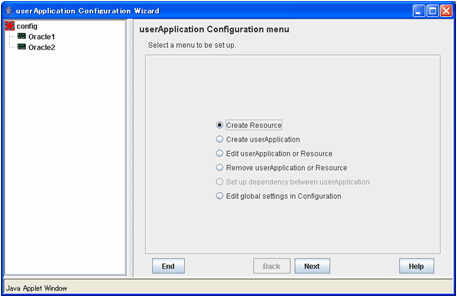
Select “Oracle” from the “Resource type” list.
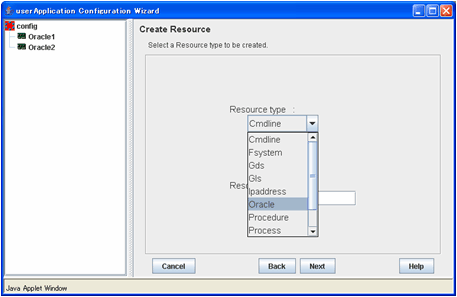
For changing a resource name, select “ApplicationName”, and change the name. If not, skip this step.

Information
Based on the value (SubApplicationName) entered in “ApplicationName” here, the Wizard for Oracle resource name is created on the RMS. For details, see “2.3.2 Oracle Software Installation and Configuration”.
For creating and registering an Oracle RAC instance resource, select “AdditionalRAC11gR2Instance”.
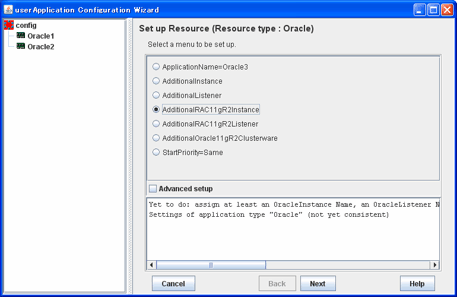
Enter Oracle user name.

Enter or select a directory path where Oracle Database was installed.

Note
After OracleHome entered, it may take few seconds to transition to the next screen. This is because a list of Oracle RAC instance SID is acquired from Oracle RAC.
If Oracle user and OracleHome entered ware incorrect, the list will not be displayed.
A list of registerable Oracle RAC instance SID is displayed.
Check “Advanced setup”, then specify a node with “ScopeFilter”.

Input the name of a host where Oracle RAC instance SID that will be registered belongs to.
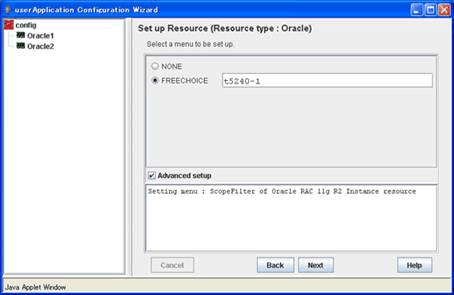
Select Oracle RAC instance SID.
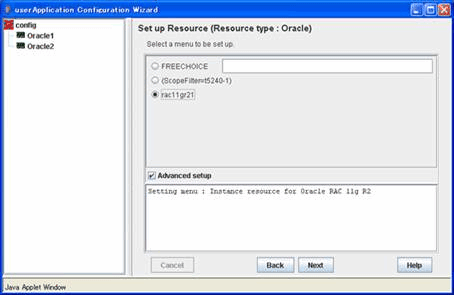
Enter Grid user name.

Note
If your Oracle RAC environment has one user for the Oracle Grid Infrastructure and the Oracle Database installations, enter Oracle user here.
Next, enter or select a directory path where Oracle Grid Infrastructure was installed.
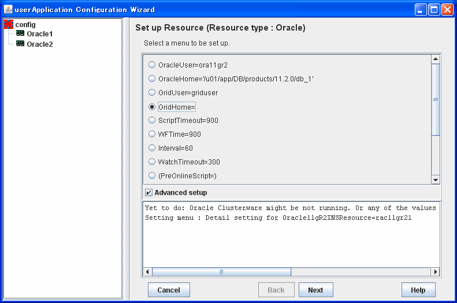
To change the settings, select setting item and click “Next” button.
To change the advanced settings, check “Advanced setup”.
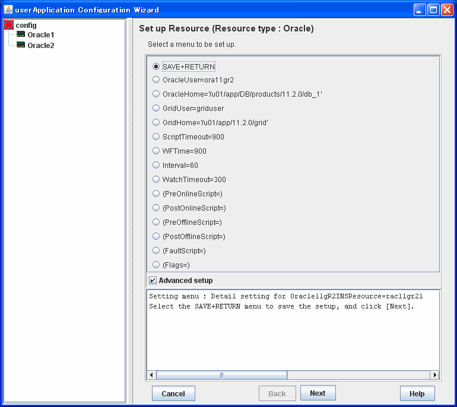
Attributes | Description | |
OracleUser | Owner user for Oracle Database | |
OracleHome | Directory path where Oracle Database was installed | |
GridUser | Owner user for Oracle Grid Infrastructure | |
GridHome | Directory path where Oracle Grid Infrastructure was installed | |
ScriptTimeout | Timeout (sec) duration of the following processing. | |
WFTime | Waiting time for resource failure recovery through Oracle Clusterware | |
Interval | Monitoring interval (sec) of Oracle RAC instance. | |
WatchTimeout | No response time (sec) during monitoring Oracle RAC instance. | |
PreOnlineScript | Executed before online processing. | |
PostOnlineScript | Executed after online processing. | |
PreOfflineScript | Executed before offline processing. | |
PostOfflineScript | Executed after offline processing. | |
FaultScript | Executed when a fault occurs. | |
Flags | NullDetector | Selects whether or not resource monitoring is enabled. |
Information
For details about Scripts, see “2.4.1 Oracle Online/Offline Script”.
For details about Flags, see “9 Appendix - Attributes” of the “PRIMECLUSTER RMS Configuration and Administration Guide”.
Note
Startup of Oracle Clusterware userApplication through PreOnlineScript
If Oracle Clusterware and Oracle RAC instance are registered in different userApplication (Configuration A), set up the following script in PreOnlineScript of the Oracle RAC instance resource;
/opt/FJSVclora/sbin/clorastartwait <userApplication with Oracle Clusterware>
Specify the following userApplication:
For app3 : app1
For app4 : app2
This setting enables that a userApplication including Oracle Clusterware resource starts up before starting up of userApplication including Oracle RAC instance resources.
In ScriptTimeout, set time to have added at least 30 or more (second) to the largest one among as follows.
The startup time of the Oracle RAC instance (confirm Oracle alert log)
The stop time of the Oracle RAC instance (confirm Oracle alert log)
The start time of the <userApplication with Oracle Clusterware> specified for clorastartwait script in PreOnlineScript (confirm RMS log file)
WFTime
In Oracle RAC 11g R2, Oracle Clusterware will recover a failure of an Oracle RAC instance or a listener instance. In PRIMECLUSTER Wizard for Oracle, the wait time for the failure recovery can be set for WFTime.
If WFTime=PersistentWarning is set, completion of the failure recovery will be waited forever. In the meantime, an RMS resource will enter Warning, so userApplication will not be degenerated. As soon as recovery is detected, the RMS resource will get back to Online.
If WFTime=ImmediateFault is set, completion of the failure recovery will not be waited but an RMS resource will be considered as fault. As soon as the RMS resource fails, userApplication will be degenerated.
WFTime=<second> is set, completion of the failure recovery will be waited for a certain period of time. After the predetermined amount of wait time passes, an RMS resource will be considered as fault then userApplication will be degenerated. During the wait time, the RMS resource indicates Warning. If recovery is detected within the wait time, the RMS resource will get back to Online.
The relation between WFTime and WatchTimeout
If the response from the Oracle RAC instance is not received before WatchTimeout, the RMS resource and the userApplication will be as follows.
If WFTime=PersistentWarning is set, the userApplication will not be degenerated in the state of Warning even if the watch timeout is continuously generated. As soon as recovery is detected, the RMS resource will get back to Online.
If WFTime=ImmediateFault is set, the RMS resource will be considered as fault when the watch timeout is generated continuousness two times. As soon as the RMS resource fails, userApplication will be degenerated.
WFTime=<second> is set, when the watch timeout is generated continuousness two times, the RMS resource and the userApplication will be as follows.
If the accumulation of time without the response from the Oracle RAC instance is shorter than WFTime, the RMS resource will get back to Warning.
If the accumulation time is longer than WFTime, the RMS resource will be considered as fault. As soon as the RMS resource fails, userApplication will be degenerated.
Flags
Flags=<Abbreviation> indicates that the flag attribute is enabled.
Check that the advanced settings are correctly set, and then save the settings by selecting “SAVE+RETURN”.
Note
In the following cases, “SAVE+RETURN" is not displayed.
- Oracle Clusterware has stopped.
- The setting of the Oracleuser, the Oraclehome, the Griduser, and the Gridhome is wrong.
The reason of this is not to be able to execute the command of Oracle RAC, and not to be able to acquire information for the setting of the Oracle RAC instance resource.

When "SAVE+RETURN" is not displayed, confirm that Oracle Clusterware is running, and confirm setting of OracleUser, OracleHome, GridUser and GridHome. When Oracle Clusterware is not running, start Oracle Clusterware. Afterwards, select either of attribute, and press "RETURN" without doing anything. (Move to other screens, and return to former screen again. )
For the method to confirm that Oracle Clusterware is running, refer to the first note of "2.3.5 userApplication with Oracle RAC Instances and Listeners".
For creating and registering an Oracle RAC listener resource, select “AdditionalRAC11gR2Listener”.
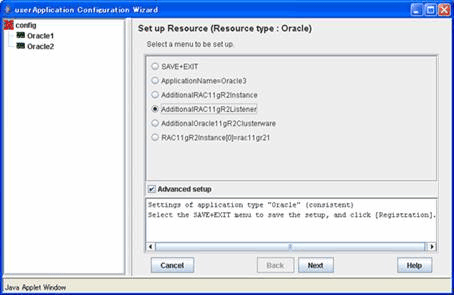
Enter Grid user name.

Enter or select a directory path where Oracle Grid Infrastructure was installed.
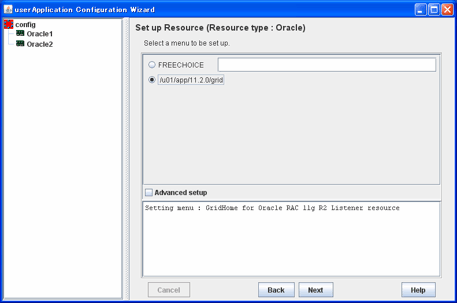
Select Oracle RAC listener.
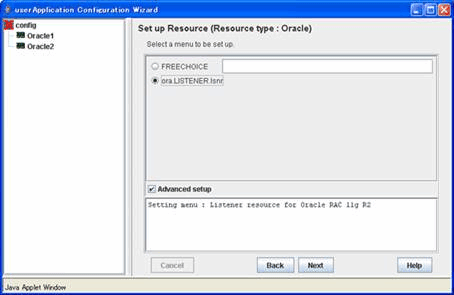
To change the settings, select setting item and click “Next” button.
To change the advanced settings, check “Advanced setup”.

Attributes | Description | |
GridUser | Owner user for Oracle Grid Infrastructure | |
GridHome | Directory path where Oracle Grid Infrastructure was installed | |
ScriptTimeout | Timeout (sec) duration of the following processing. | |
WFTime | Waiting time for resource failure recovery through Oracle Clusterware | |
Interval | Monitoring interval (sec) of Oracle RAC instance. | |
WatchTimeout | No response time (sec) during monitoring Oracle RAC instance. | |
PreOnlineScript | Executed before online processing. | |
PostOnlineScript | Executed after online processing. | |
PreOfflineScript | Executed before offline processing. | |
PostOfflineScript | Executed after offline processing. | |
FaultScript | Executed when a fault occurs. | |
Flags | NullDetector | Selects whether or not resource monitoring is enabled. |
Information
For details about Scripts, see “2.4.1 Oracle Online/Offline Script”.
For details about Flags, see “9 Appendix - Attributes” of the “PRIMECLUSTER RMS Configuration and Administration Guide”.
Note
WFTime
This is the same as Oracle RAC instance resource. For details, see the Note of step 10.
Flags
Flags=<Abbreviation> indicates that the flag attribute is enabled.
Check that the advanced settings are correctly set, and then save the settings by selecting “SAVE+RETURN”.
Check that the Oracle RAC instance and listener are set, then save the settings by selecting “SAVE+EXIT”.

Repeat steps 1 to 18 for each node.
Select “Create userApplication” in the “userApplication Configuration” menu and include the created Oracle resource (Oracle RAC instance resource, listener resource) in userApplication.
For further details of the attributes of userApplication, refer to “2.3.3 userApplication and Resource Configuration”.